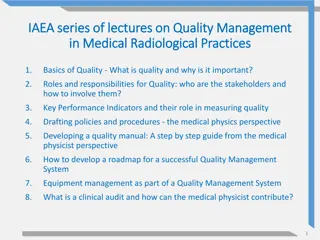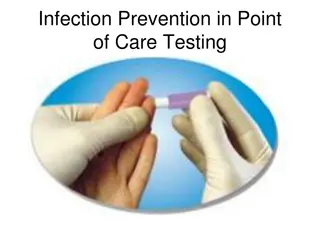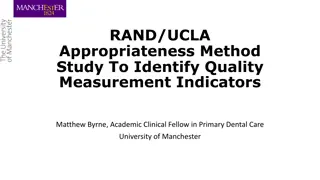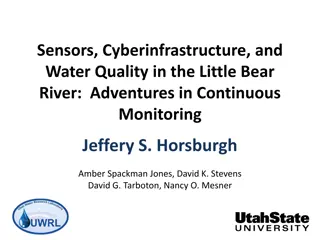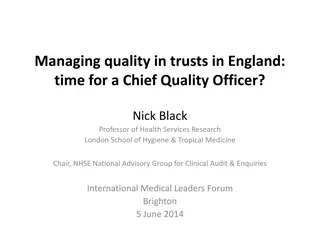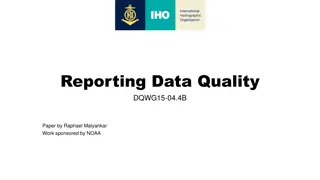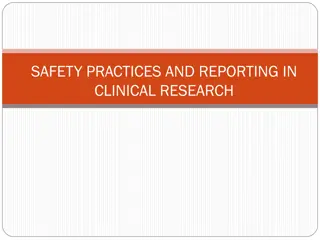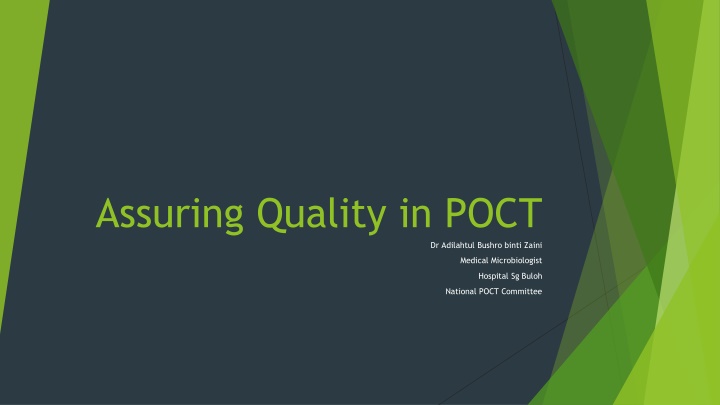
Assuring Quality in POCT: Importance, Processes, and Quality Assurance
Explore the vital role of Point-of-Care Testing (POCT) in diagnosing and monitoring infectious diseases, mitigating pandemics, and controlling outbreaks. Learn about the flow of POCT processes, specific tests for infectious pathogens in Malaysia, and the crucial aspect of quality assurance in POCT implementation.
Download Presentation

Please find below an Image/Link to download the presentation.
The content on the website is provided AS IS for your information and personal use only. It may not be sold, licensed, or shared on other websites without obtaining consent from the author. If you encounter any issues during the download, it is possible that the publisher has removed the file from their server.
You are allowed to download the files provided on this website for personal or commercial use, subject to the condition that they are used lawfully. All files are the property of their respective owners.
The content on the website is provided AS IS for your information and personal use only. It may not be sold, licensed, or shared on other websites without obtaining consent from the author.
E N D
Presentation Transcript
Assuring Quality in POCT Dr Adilahtul Bushro binti Zaini Medical Microbiologist Hospital Sg Buloh National POCT Committee
Introduction POCT has important role to play in diagnosis, treatment and monitoring of infectious disease In a larger scale POCT has prove itself as a very important role in control and mitigate pandemic in particular.
Flow of process following POCT testing As for many POCT in infectious disease, the result in needed as urgent for example Dengue RTK, PCT. Others maybe semiurgent for example HIV antibody, HCV and Syphilis antigen It serve as a screening tool before proceed to lab based confirmatory test. There is a need for complete algorithm including patient selection (preanalysis), analysis and post analysis before embark on POCT. Example-Hep C & HIV RTK included in national diagnostic algorithm. As for syphilis antigen, the algorithm need to be informed and training would be very helpful
POCT for Infectious disease pathogen in Malaysia COVID antigen RTK 1. Dengue Combo RTK 2. HIV antibody RTK 3. HCV antigen RTK 4. Syphilis antigen RDT 5.
Quality Assurance A program to assured the quality of POCT test that is being provided All party providing the test is responsible for assuring the quality start from the policy maker and stake holder to the end user. In central lab where the test is highly sensitive/accurate and in controlled environment, there is also program to assure quality, whatmore in a periphery where the turnover rate of patient is high.
Start from the Evaluation of test method Acceptance Test Method Verification IQC(internal quality control) EQC Audit & Assessment
Evaluation of the test method During the market survey, potential candidates can send a sample of kit for evaluation by designated laboratory Done at designated laboratory e.g. IMR,MKAK Sample is tested on a known sample(positive& negative) and report on sensitivity/specificity is produced. Based on specification set by the tender committee, performance evaluation report should be included. Only kit that passed the requirement will be considered in technical committee or any type of purchasing(direct purchase etc). Technical committee will give recommendation based on the kit performance and other criteria
Acceptance test Every batch of production is different. There may be lot to lot variation. Therefore there must be quality check on this. Manufacturer usually have their own QC check before release the batch. However, there are still who don t have that good manufacturing practice. Example: recent DCTK manufacturer. The best is that manufacturers are ISO accredited. Another way to ensure a quality product is received is to ask the supplier to send for evaluation at designated laboratory in every shipment or at regular interval. Example: testing at every consignment received (HIV). This can avoid a faulty kit distributed and much more difficult to recall.
Method Verification Although the test kit already approved by the tender committee for purchasing, testing at end user is still mandatory to ensure it meets the intended use. The kit may be of different lot, different shipment from the evaluation. In addition, the facility condition and local personel may have the impact on the kit performance. By doing method verification, the exact performance of the kit is known. In this process, the test is run with known sample and repeatedly with different user. Report on accuracy and reproducibility is produced. Method verification can be done either at selected site or all site and the vendor should help in this process. Method verification done at Pathology Department for DCTK able to detect low sensitivity test kit, markedly different from Evaluation report during tender process (30% vs 95% that claimed by manufacturer)
Monitoring-IQC The frequency ICQ mentioned in National POCT Policy & Guideline Divided to High, Moderate, Low complexity Immunochromatographic test(ICT)/ Lateral flow Assay(LFA) considered low complexity test. MONTHLY testing is a minimum requirement. Testing with positive & negative control(1 respectively) Ideally the box should comes with positive and negative LIQUID CONTROL. However, this will incur higher cost. Alternatively, testing with known sample is ACCEPTABLE.
Another option is control material is included in every batch lot only and done at designated testing site. Vendor should help in this process (put in specification). Example: Glucometer IQC has ICQ provided by manufacturer for all users. Testing for control band is not sufficient for performance check. This process should be oversight by a laboratory personnel as a gatekeeper for quality in testing. Example there was a case where testing of tap water on glucometer give reading of 3-4mmol/L
EQC-External Quality Control External quality assessment (EQA)program, a group of laboratories analyze the same specimens and submit their results to a central facility where the data are examined for outliers, it is also known as proficiency test Proficiency test (PT) is mandatory in quality monitoring Quality of reagent and competency of personnel are being evaluated simultaneously. PT is provided by ISO 17043 accredited provider. Example RCPA(Australia), API (USA) or KKM(IMR/MKAK) This requirement should be included in a tender specification. Example: HIV antibody test(IMR provided samples for 5 KK and Hospital). DCTK: Testing the kit with RCPA samples detect low sensitivity of DCTK
Other element for quality for POCT Document control- Local procedures, processes and record retention guidelines should be followed. Original results and evaluation approval should be kept at one location, and all locations using the device are to have a copy and/or access to the documentation for referencing at any time. Training-All POCT users must receive training for the POCT device they will be using. Users must be deemed competent to perform the testing before being granted access.
Audit-The most significant risk associated with POCT is the failure of clinical users to follow POCT policies and procedures. This can result in patient safety issues and jeopardize program compliance with accreditation standards. Quality indicator monitoring
Conclusion POCT has important role to provide rapid and simple test for efficient infectious disease management However, the test can be as good as its get when it is properly planned and executed. Quality Assurance Programme should be in every policy maker consideration because the test was taken away from the central lab where the environment is controlled and properly monitored.



